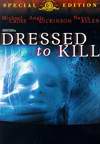Dressed To Kill
MGM Home Entertainment
Cast: Michael Caine, Angie Dickinson, Keith Gordon
Extras: Documentary, Featurettes, Photogalleries, Theatrical Trailer
Rating:
Originally written by DePalma back in 1974, "Dressed to Kill" introduces Kate Miller (Angie Dickinson), a lonely and sexually insecure woman, unhappy in her marriage and uncertain of her own sexual worth. After the usual morning ‘wham-bang special’ she endures under her husband, Kate turns to her psychiatrist, Dr. Elliott (Michael Caine) for emotional rescue. After Elliott rejects her sexual advances, Kate flees to a local museum for quiet reflection. The afternoon, however, proves intriguing as she suddenly finds herself engaged in an unspoken courting with a mysterious stranger. The flirtatious back-and-forth pursuit ends with Kate acting out her impulsive fantasies with the man, first in a taxicab and later at his apartment.
"Dressed to Kill" is presented as an erotic shocker – an aspiration it achieves easily. Moreover, it’s a compelling and disquieting commentary upon the guilt, paranoia, and hypocrisies evident in our culture – originally leveled at 1980’s sensibility yet stingingly accurate even today. In it, DePalma holds up a soul-bearing mirror to reveal the deepest fears, phobias, and dangerous preoccupations within many of us. Yet the film was released in the midst of the feminist movement and, due to its visual pursuit and brutality toward women, resulted in the director being branded a misogynist. Audiences, of course, flocked to theaters to see what all the furor was about (you know, the sort of thing studios yearn for today), making "Dressed to Kill" a major commercial hit for DePalma and Samuel Z. Arkoff’s now-defunct Filmways Pictures.
With highly erotic opening sequences featuring Angie Dickinson (TVs ‘Police Woman,’ mind you) at "play" in the shower, followed by an aggressive lovemaking scene, the viewer is immediately caught off guard yet compelled to look on in voyeuristic fascination. From there, DePalma proceeds to skillfully manipulate the viewer through an array of shocking sequences, visual clues, and even a couple red herrings. At use is a stunning display of split-screen imagery, sweeping crane shots, and one of the best examples of "pure cinema" storytelling (the museum scene) where the actors’ movement and expression, intensified by composer Pino Donaggio’s evocative score, is the only "dialog" present – a scene which runs a full 10 minutes. From a performance standpoint, the principals all deliver in top-notch fashion (especially Dickinson) and are to be commended.
MGM Home Entertainment presents "Dressed to Kill" in a 16×9 <$16x9,anamorphic> transfer framed at the film’s original 2.35:1 aspect ratio. While this is definitely a leap above previous fuzzy and ineffective pan-and-scan video versions, the overall picture here isn’t of the quality that I’ve come to expect from DVD. The source print shows quite a bit of damage in the way of visible specks, scratches, and a seemingly nasty splice at one point. The transfer is generally good, delivering nice shadows and deep blacks. Colors are vibrant and flesh tones are realistic. There’s excellent detail in the image but be prepared for occasional graininess and a bit of shimmering. That aside, it’s great to once again see the entire Panavision frame that DePalma utilizes to the fullest.
This is a special edition, indeed, as evidenced by the generous extras included on the disc. First and foremost, viewers can choose between the unrated European cut of the film or the US theatrical R-rated version. Next is a 45-minute documentary, "Making of a Thriller," which traces the production through new interviews with DePalma, Dickinson, Allen, Gordon, Franz, and producer George Litto. Also included are three featurettes: "Slashing Dressed to Kill" explores battles with the MPAA ratings board to avoid a ‘X’ certification; "A Film Comparison: 3 Versions of Dressed to Kill" provides a clever split-screen analysis of scenes as they appeared in the unrated, R-rated, and television versions; and "Dressed to Kill: An Appreciation by Keith Gordon" in which the actor-turned-filmmaker recounts working on the production. Beyond these, there are animated photogalleries featuring production stills as well as promotional materials. Wrapping it up is the original theatrical trailer.







